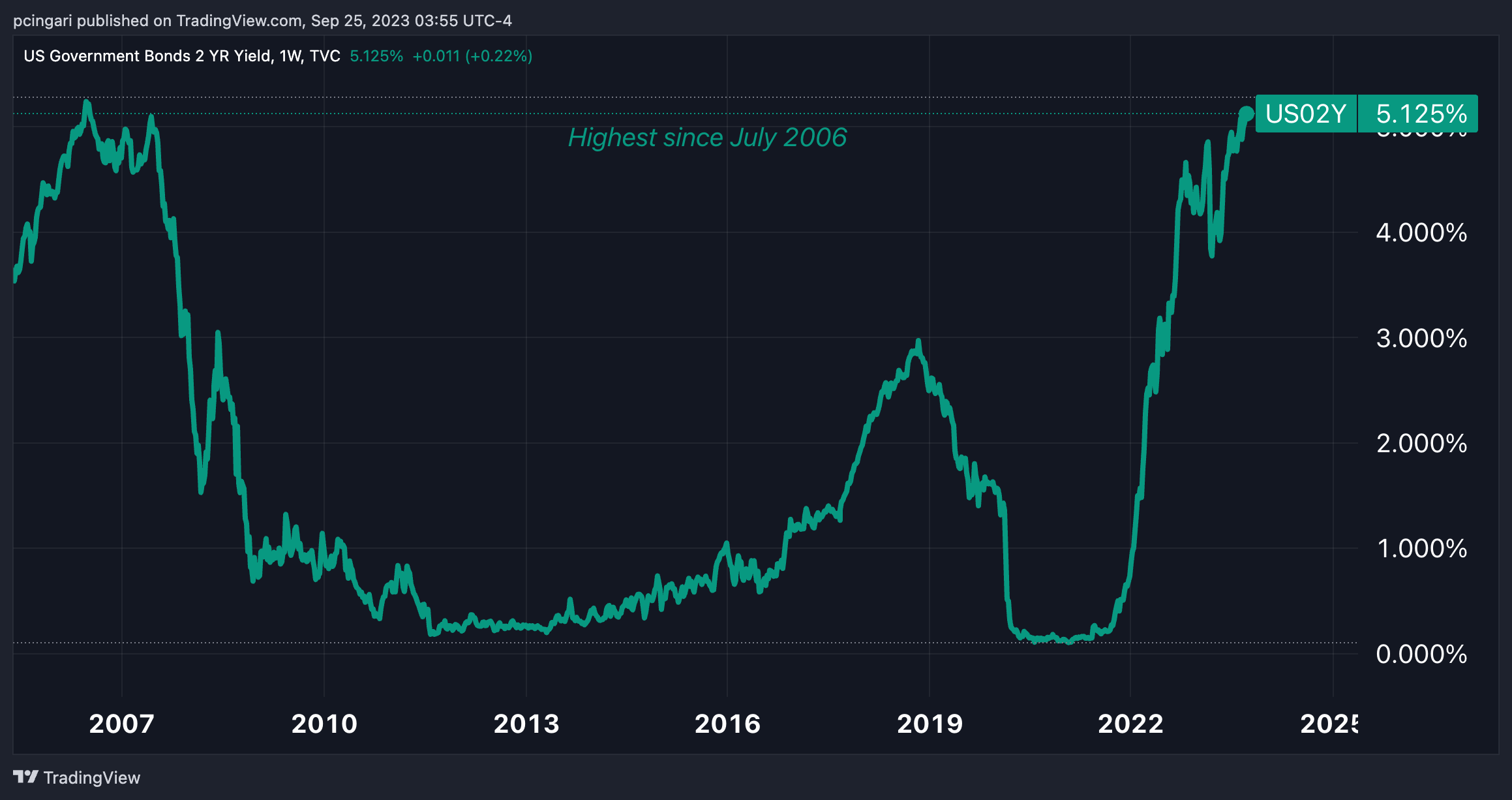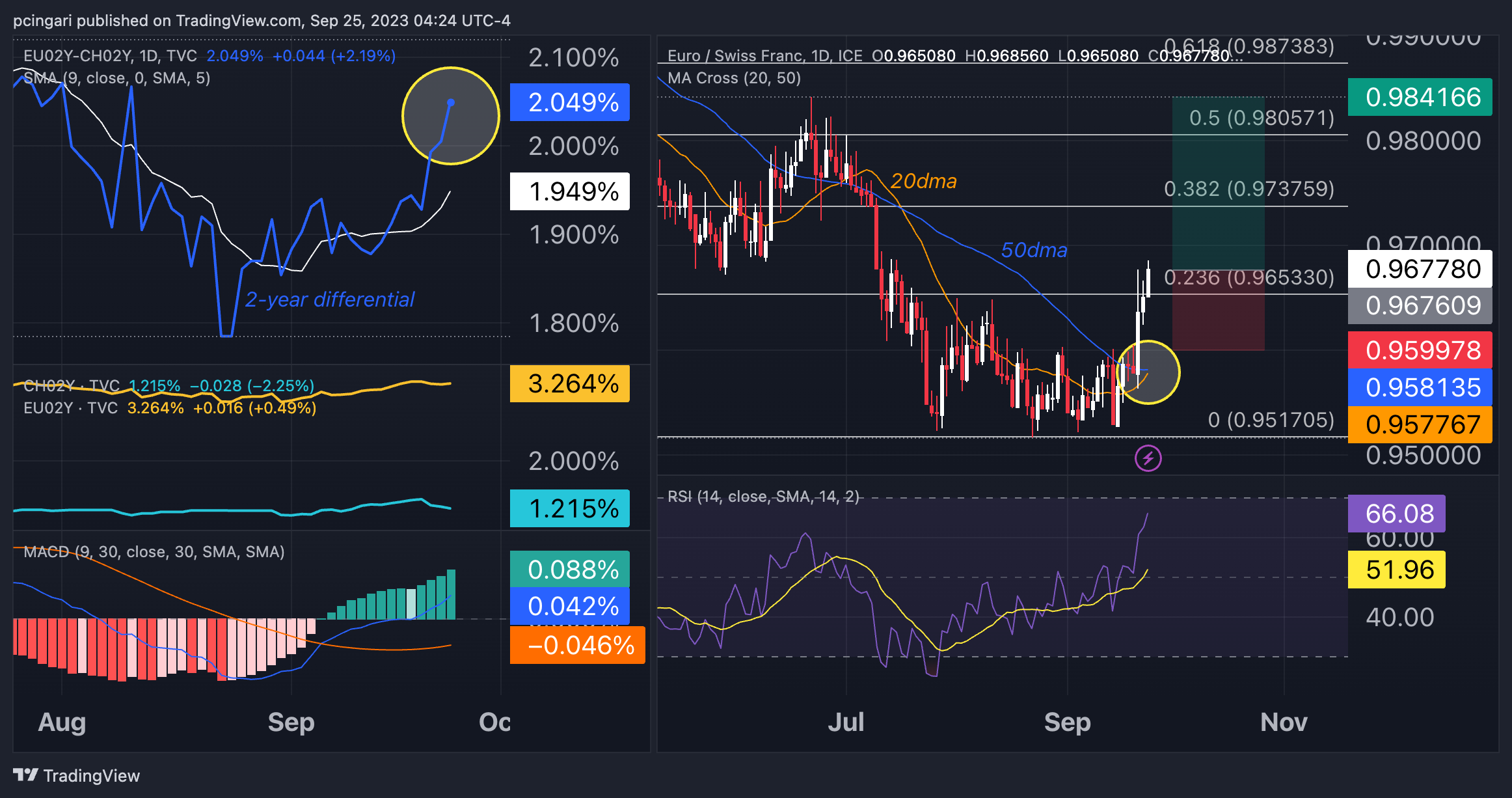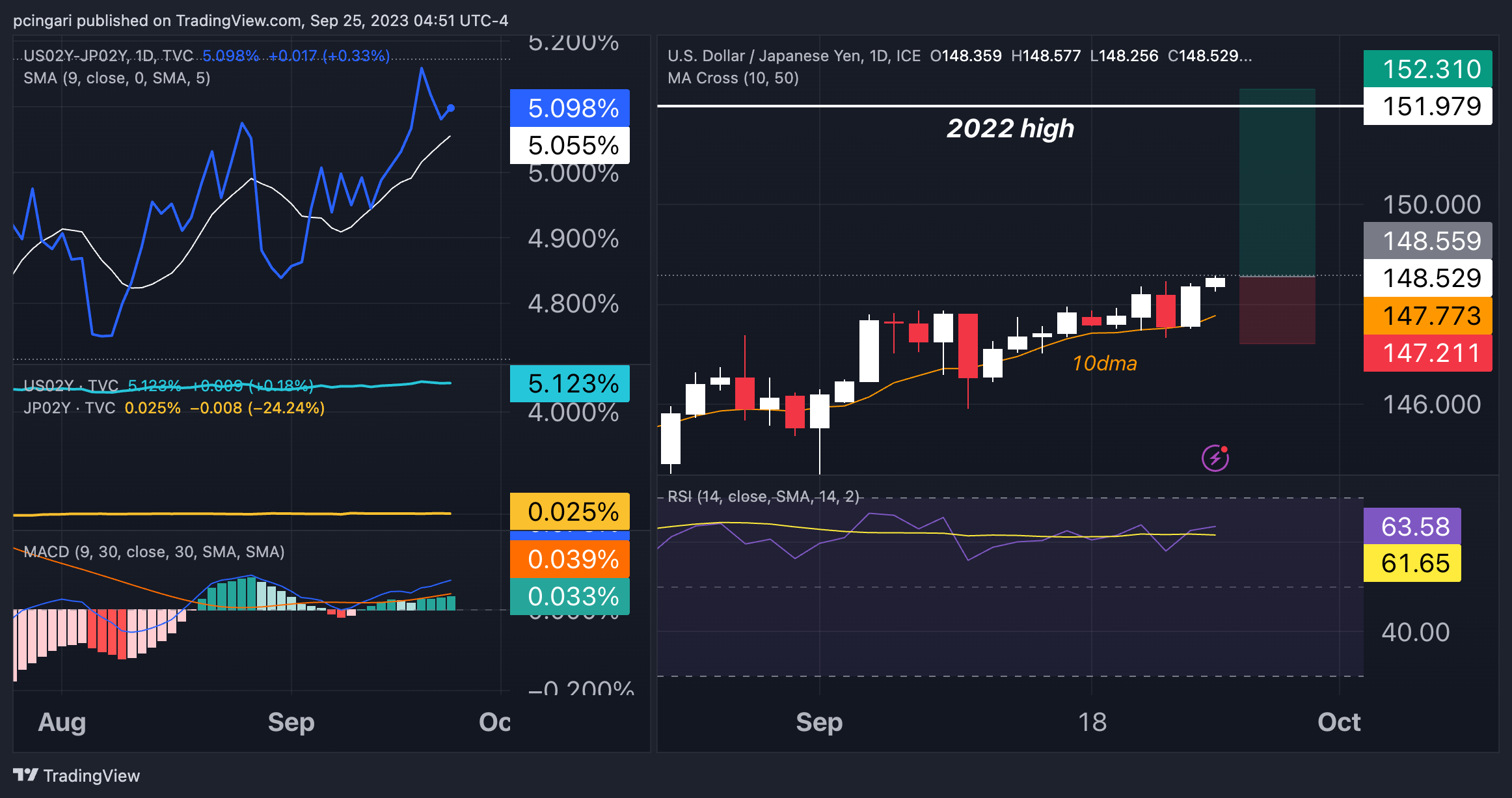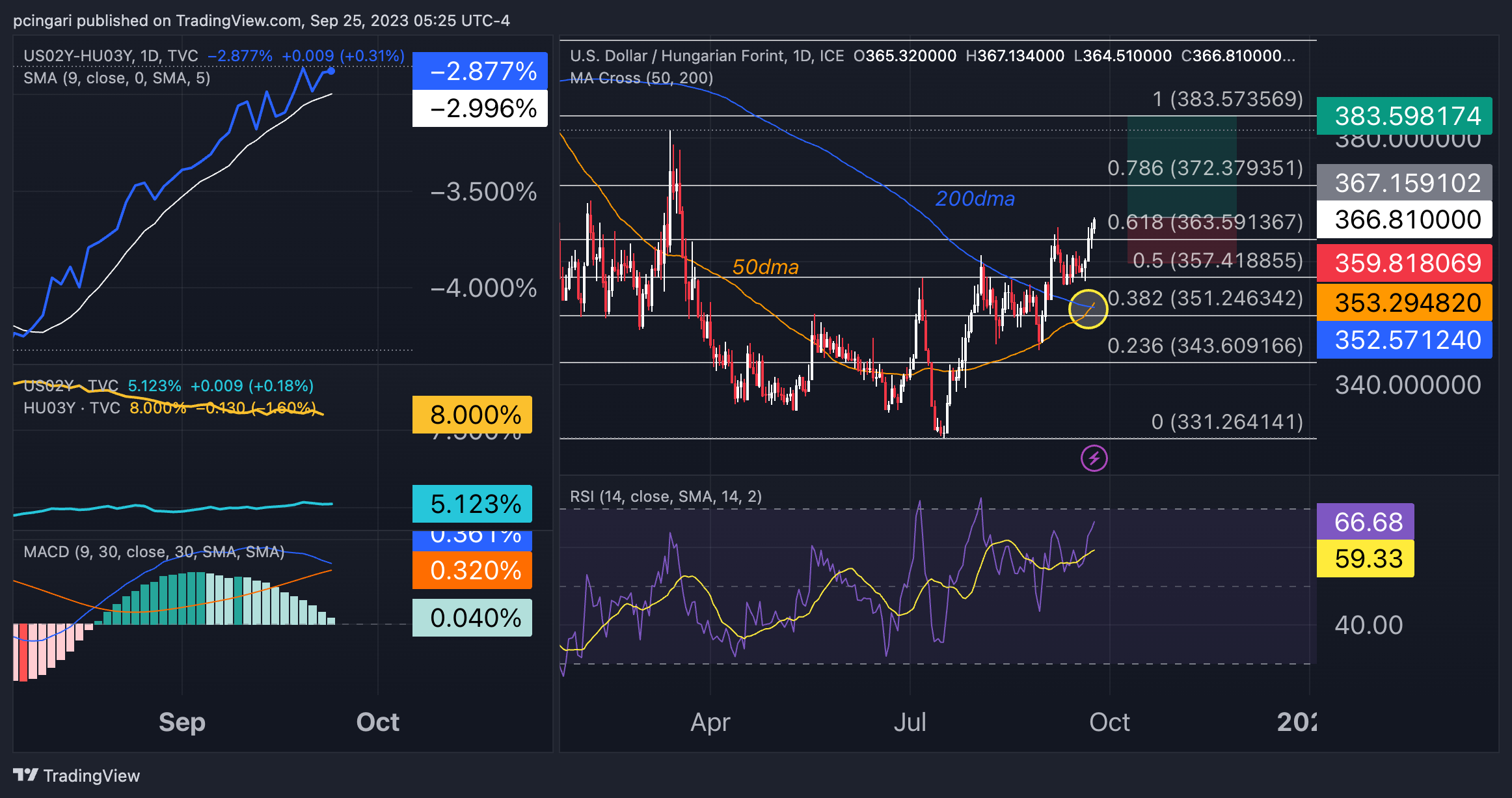It has been a week filled with central bank meetings, and there have been some surprises compared to the forecasts.
Forex Market Review: What Happened Last Week
The Federal Reserve, as expected, decided to leave interest rates unchanged at 5.25%-5.50%. However, their macroeconomic projections now anticipate another rate hike in 2023, while they have lowered their downside expectations for 2024 to just 50 basis points, down from 100 basis points in the June projections. Powell reiterated his intention to maintain higher rates for an extended period, emphasizing that the battle against inflation is far from over.
The Fed's hawkish stance resulted in the U.S. dollar closing out its tenth consecutive week of gains, with the U.S. dollar index (DXY) reaching a six-month high.
Meanwhile, the Bank of England surprised the market by keeping rates unchanged at 5.25%, halting their rate hike campaign after nearly two years. Additionally, two other major central banks, the Swiss National Bank (SNB) and the Bank of Japan (BoJ), also decided to maintain their current interest rates. The SNB's decision went against market expectations of a 25 basis point increase, while the BoJ expressed disappointment by reiterating their ultra-accommodative stance, citing that the inflation target is still out of reach.
Both the British pound (GBP) and the Swiss franc (CHF) were the worst-performing currencies of the week, each falling by more than 1% against the dollar. The euro (EUR) and the Japanese yen (JPY) also experienced slight declines (0.2%) against the greenback, with the euro currently enduring its worst weekly negative streak ever. In contrast, the New Zealand Dollar (NZD) outperformed in the G10 basket, supported by a significant upward revision of its Q2 GDP figures. Another strong performer was the Norwegian Krone (NOK) after Norges Bank increased rates by 25 basis points.
Looking ahead, the upcoming week will feature the release of the U.S. Price Consumption Expenditure (PCE) Index for August, which is the Fed's preferred inflation gauge. Additionally, there will be several Fed speakers scheduled to address the public, including Chair J. Powell on Thursday. In Europe, attention will be on the Eurozone's September inflation rate and consumer confidence in Germany. In other regions, Australia will publish the CPI data for August, and the Bank of Japan will release the minutes of its recent meeting.
Key Economic Events To Monitor This Week
United States:
- PCE Price Index (Fri.): 3.3% year-on-year prior, 3.5% expected
- Core PCE Price Index (Fri.): 4.2% y/y prior, 3.9% expected
- Q2 GDP growth rate (final) (Thu.): 2.2% prior
Euro Area:
- Inflation rate for September (Fri.): 5.2% y/y prior, 4.5% expected
- Core inflation rate (Fri.): 5.3% prior, 4.8% expected
- ECB’s Lagarde speech (Fri.)
- Germany’s Gfk Consumer Confidence: -25.5 prior, -25.5 expected
Other Data To Follow:
- UK Q2 GDP growth rate (final): 2% expected
- Australia’s CPI: 9% y/y prior, 5.2% expected
- Hungary Interest rate decision: 14% prior
Chart Of The Week: US 2-Year Yields Rise To 17-Year Peak, As Fed Hints To Keep Rates Higher For Longer

New Trades for The Week
Long EUR/CHF
- Entry: 0.9675
- Take profit: 0.9840
- Stop Loss: 0.96
- Risk/Reward Ratio: 2.2

EUR/CHF Fundamental Analysis:
The 2-year yield differential between a euro area government bond and its Swiss counterpart has once again surpassed 2%. This shift can be directly attributed to the SNB’s notably more dovish stance compared to the ECB during their respective meetings.
This particular factor should favor the euro in terms of carry advantages over the Swiss franc, potentially prompting an increase in the exchange rate to levels more in line with this yield differential. It's worth noting that while economists anticipate a very low inflation rate for the euro area in the upcoming week, recent increases in energy prices over the past month could lead to unforeseen surprises.
EUR/CHF Technical Analysis:
The EUR/CHF currency pair has surged above both the 20 and 50-day moving averages, with these two indicators now poised to form a 'golden cross.' Over the past three trading sessions, the rally has also surpassed the 23.6% Fibonacci retracement level, calculated from the low-to-high range of 2023. The Relative Strength Index (RSI) is on an upward trajectory and approaching overbought territory, signaling that bullish sentiment is driving the short-term trend.
If this bullish momentum holds, there is potential for the pair to target the high from June at 0.9840, surpassing the 50% Fibonacci retracement level. However, a pullback below the 0.96 level, which corresponds to where the pair was trading before the Swiss National Bank (SNB) meeting, would invalidate this thesis.
Long USD/JPY
- Entry: 148.56
- Take Profit: 154
- Stop Loss: 0.6032
- Risk/Reward Ratio: 2.80

USD/JPY Fundamental Analysis:
The BoJ missed an opportunity to stem the weakening of the yen. Governor Ueda stated that the BoJ would patiently persist with its monetary easing policy and would respond to economic developments. He also reiterated his readiness to implement additional easing measures if necessary. This setback represents another disappointment for yen bulls.
In contrast, the Federal Reserve adopted a more hawkish tone than anticipated, reducing the likelihood of rate cuts in 2024. Even if another rate hike by the Fed doesn’t occur this year, the current fed funds rate of 5.5% presents a significant interest rate advantage compared to Japan's still-negative interest rates. Consequently, the 2-year yield differential between the two regions has begun to widen once again. In summary, these developments could indicate a continuation of the bullish trend for USD/JPY. Markets will likely test the BoJ’s tolerability to currency weakness, potentially bringing it closer to a decision on FX intervention
USD/JPY Technical Analysis:
It's a common market tendency to retest extreme levels and the 2022 high at 152 is now within reach, with just a 2.5% gap to bridge.
In recent weeks, price movements have consistently found robust support at the 10-day moving average, further reinforcing the potential for an upward push.
Additionally, the RSI has remained steadily above the 60 mark, indicating sustained strength in the trend. For risk management, a stop could be set at 147.20, positioned below the level at which the pair was trading prior to the last Fed/BoJ meeting.
Long USD/HUF:
- Entry: 366.97
- Take Profit: 383.60
- Stop Loss: 359.81
- Risk/Reward Ratio: 2.2

USD/HUF Fundamental Analysis:
The National Bank of Hungary (NBH) is scheduled to convene for a rate-decision meeting on Tuesday, following its decision to reduce the one-day deposit rate by 100 basis points to 14.0 percent during the August meeting.
Inflation dipped to 16.4% in August 2023, marking its lowest point in a year, and forecasts suggest it may continue to decrease in the upcoming months. Consequently, the NBH could maintain its dovish stance, potentially implementing additional rate cuts that could negatively impact the currency.
Furthermore, the two-year yield differential between the United States and Hungary has exhibited an upward trajectory since mid-August and is anticipated to climb further. This increase is expected to exert upward pressure on the USD/HUF pair.
USD/HUF Technical Analysis:
The pair has break above the September resistance, and since mid-July, it has retraced more than half of the bearish trend observed throughout 2023. The possibility of a complete retracement is becoming increasingly plausible, especially given the recent occurrence of a 'golden cross' involving the 50 and 200-day moving averages.
For USD/HUF bulls, the 2023 high at 383.60 could be an achievable target, representing a potential upside. To manage risk effectively, consider placing a stop at 359.81.
Open trading ideas:
- Short GBP/AUD
- Opened on September 18th at 1.9250
- Take Profit: 1.8600
- Stop Loss: 1.9560
- Profit & Loss: +1.1%
- Short NZD/USD
- Opened on September 20th at 0.5960
- Take Profit: 0.5731
- Stop Loss: 0.6032
- Profit & Loss: +0.2%
- Short CHF/JPY
- Opened on September 18th at 164.61
- Take Profit: 155.34
- Stop Loss: 167.00
- Profit & Loss: +0.9%
- Short GBP/JPY
- Opened on September 11th at 182.96
- Take Profit: 175.9
- Stop Loss: 185.6
- Profit & Loss: +0.8%
- Short EUR/JPY
- Opened on September 11th at 156.78
- Take Profit: 151.88
- Stop Loss: 158.5
- Profit & Loss: -0.6%
- Long USD/PLN:
- Opened on September 11th at 4.3058
- Take Profit: 4.6311
- Stop Loss: 4.1745
- Profit & Loss: +0.4%
- Short GBP/CHF
- Opened on September 4th at 1.1156
- Take Profit: 1.09
- Stop Loss: 1.1250
- Profit & Loss: +0.4%
- Short EUR/AUD
- Opened on September 4th at 1.6708
- Take Profit: 1.6200
- Stop Loss: 1.6900
- Profit & Loss: +0.9%
- Long USD/CHF
- Opened on August 28th at 0.8840
- Take Profit: 0.9250
- Stop Loss: 0.8680
- Profit & Loss: +2.9%
- Long USD/CAD
- Opened on August 21st at 1.35
- Take Profit: 1.3860
- Stop Loss: 1.3350
- Profit & Loss: -0.1%
- Short EUR/CAD:
- Opened on August 14 at 1.4730
- Take Profit: 1.4280
- Stop Loss: 1.49
- Profit & Loss: +2.7%
- Short NZD/CAD:
- Opened on July 24th at 0.8174
- Take Profit: 0.7975
- Stop Loss: 0.8263
- Profit & Loss: +1.9%




